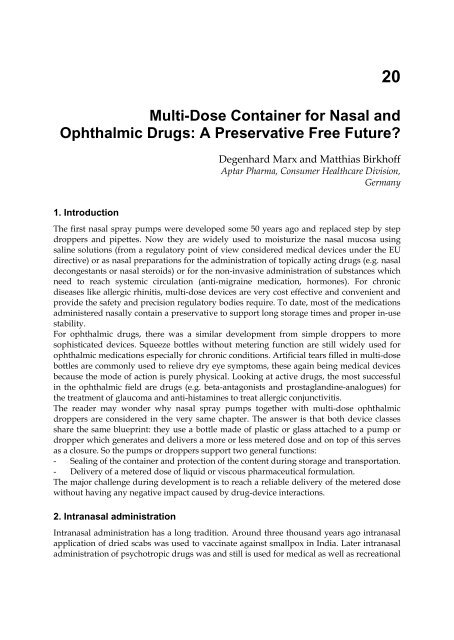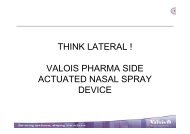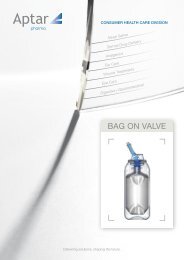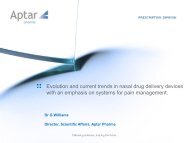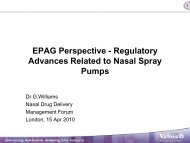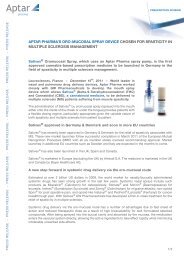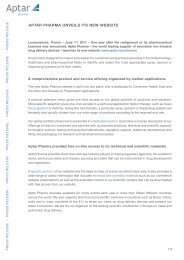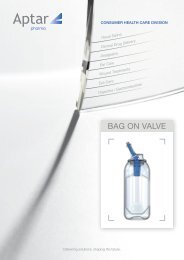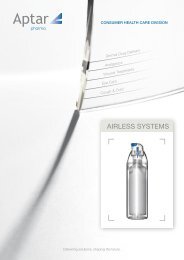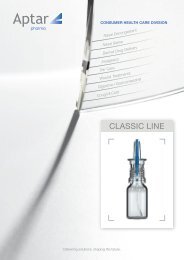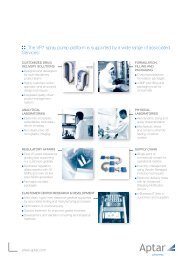Multi-Dose Container for Nasal and Ophthalmic Drugs: A ... - Aptar
Multi-Dose Container for Nasal and Ophthalmic Drugs: A ... - Aptar
Multi-Dose Container for Nasal and Ophthalmic Drugs: A ... - Aptar
You also want an ePaper? Increase the reach of your titles
YUMPU automatically turns print PDFs into web optimized ePapers that Google loves.
20<br />
<strong>Multi</strong>-<strong>Dose</strong> <strong>Container</strong> <strong>for</strong> <strong>Nasal</strong> <strong>and</strong><br />
<strong>Ophthalmic</strong> <strong>Drugs</strong>: A Preservative Free Future<br />
Degenhard Marx <strong>and</strong> Matthias Birkhoff<br />
<strong>Aptar</strong> Pharma, Consumer Healthcare Division,<br />
Germany<br />
1. Introduction<br />
The first nasal spray pumps were developed some 50 years ago <strong>and</strong> replaced step by step<br />
droppers <strong>and</strong> pipettes. Now they are widely used to moisturize the nasal mucosa using<br />
saline solutions (from a regulatory point of view considered medical devices under the EU<br />
directive) or as nasal preparations <strong>for</strong> the administration of topically acting drugs (e.g. nasal<br />
decongestants or nasal steroids) or <strong>for</strong> the non-invasive administration of substances which<br />
need to reach systemic circulation (anti-migraine medication, hormones). For chronic<br />
diseases like allergic rhinitis, multi-dose devices are very cost effective <strong>and</strong> convenient <strong>and</strong><br />
provide the safety <strong>and</strong> precision regulatory bodies require. To date, most of the medications<br />
administered nasally contain a preservative to support long storage times <strong>and</strong> proper in-use<br />
stability.<br />
For ophthalmic drugs, there was a similar development from simple droppers to more<br />
sophisticated devices. Squeeze bottles without metering function are still widely used <strong>for</strong><br />
ophthalmic medications especially <strong>for</strong> chronic conditions. Artificial tears filled in multi-dose<br />
bottles are commonly used to relieve dry eye symptoms, these again being medical devices<br />
because the mode of action is purely physical. Looking at active drugs, the most successful<br />
in the ophthalmic field are drugs (e.g. beta-antagonists <strong>and</strong> prostagl<strong>and</strong>ine-analogues) <strong>for</strong><br />
the treatment of glaucoma <strong>and</strong> anti-histamines to treat allergic conjunctivitis.<br />
The reader may wonder why nasal spray pumps together with multi-dose ophthalmic<br />
droppers are considered in the very same chapter. The answer is that both device classes<br />
share the same blueprint: they use a bottle made of plastic or glass attached to a pump or<br />
dropper which generates <strong>and</strong> delivers a more or less metered dose <strong>and</strong> on top of this serves<br />
as a closure. So the pumps or droppers support two general functions:<br />
- Sealing of the container <strong>and</strong> protection of the content during storage <strong>and</strong> transportation.<br />
- Delivery of a metered dose of liquid or viscous pharmaceutical <strong>for</strong>mulation.<br />
The major challenge during development is to reach a reliable delivery of the metered dose<br />
without having any negative impact caused by drug-device interactions.<br />
2. Intranasal administration<br />
Intranasal administration has a long tradition. Around three thous<strong>and</strong> years ago intranasal<br />
application of dried scabs was used to vaccinate against smallpox in India. Later intranasal<br />
administration of psychotropic drugs was <strong>and</strong> still is used <strong>for</strong> medical as well as recreational
510<br />
Drug Development – A Case Study Based Insight into Modern Strategies<br />
purposes. Leaving these ancient therapeutic regimes behind, today the topical treatment of<br />
allergic rhinitis using anti-histamines (azelastine, levocabastine, olopatadine) or<br />
glucocorticoids (e.g. budesonide, fluticasone or ciclesonide) is well established. For this<br />
particular indication, drugs should act fast <strong>and</strong> just locally while systemic absorption should<br />
be as low as possible to avoid systemic side effects which are linked with typical oral<br />
<strong>for</strong>mulations of comparable drug substances. Since allergic rhinitis is a chronic disease, only<br />
multi-dose bottles are used there.<br />
<strong>Nasal</strong> decongestants<br />
e.g. oxymetazoline, xylometazoline,<br />
naphazoline, tetryzoline<br />
Intranasal steroids<br />
e.g. beclomethasone, budesonide,<br />
fluticasone, mometasone, ciclesonide<br />
Antihistamines<br />
azelastine, levocabastine, olopatadine<br />
Triptanes<br />
sumatriptan, zolmitriptan<br />
Analgesics<br />
fentanyl, ketorolac, (ketamine)<br />
Preferred profile<br />
Local activity only, low systemic adsorption to<br />
minimize side effects (headache <strong>and</strong> dizziness)<br />
Local activity only, low systemic adsorption to<br />
minimize systemic side effects (cortisol<br />
suppression)<br />
Local activity only, low systemic adsorption to<br />
minimize systemic side effects (sedation)<br />
Fast onset of action, high systemic adsorption to<br />
blunt migraine attacks<br />
Fast onset of action but avoid high plasma<br />
concentration peaks<br />
Table 1. Established drug classes <strong>for</strong> intranasal administration<br />
But intranasal administration has much more potential. The nasal mucosa can be used <strong>for</strong><br />
non-invasive systemic administration of drugs. The nasal mucosa in humans is around<br />
150 cm 2 , a surface which is well supplied by blood vessels. This ensures a rapid absorption<br />
of most drugs <strong>and</strong> can generate high blood levels. This administration route avoids the first<br />
pass metabolism which needs to be taken into account following oral administration. This<br />
bypassing of the gastric system even enables the delivery of peptide hormones. Calcitonin<br />
<strong>and</strong> desmopressin are on the market <strong>for</strong> years now, insulin <strong>and</strong> glucagon under clinical<br />
development <strong>for</strong> this administration route (Leary et al., 2008).<br />
Intranasal administration is considered a non-invasive administration route <strong>and</strong> easy to do<br />
<strong>for</strong> self-administration or <strong>for</strong> care-givers with low potential <strong>for</strong> injuries or disease<br />
transmission (hepatitis B, HIV). This is of special importance if fast pain relief is required<br />
<strong>and</strong> patient’s ability to deal with injections is impaired. Intranasal triptanes <strong>for</strong> migraine<br />
treatment, fentanyl to stop breakthrough pain <strong>and</strong> ondansetrone to relieve nausea take<br />
advantage of this administration route. For these indications, single dose devices or multidose<br />
devices with counting or lock-out mechanisms are available to reduce the risk of<br />
unintended overdosing or misuse.<br />
A controversial discussion is ongoing regarding direct nose to brain drug delivery. This<br />
would open the door to a targeted treatment <strong>for</strong> various CNS diseases like Alzheimer,<br />
Parkinson, <strong>and</strong> epilepsies. Un<strong>for</strong>tunately, the available literature does not suggest consistent<br />
findings, more research is required here (Wen, 2011).
<strong>Multi</strong>-<strong>Dose</strong> <strong>Container</strong> <strong>for</strong> <strong>Nasal</strong> <strong>and</strong> <strong>Ophthalmic</strong> <strong>Drugs</strong>: A Preservative Free Future 511<br />
Indication Bioavailability [%]<br />
Azelastine Topical anti-histamine 40<br />
Budesonide Topical glucocorticoid 34<br />
Fentanyl Opiate analgesic 80-90<br />
Sumatriptan Anti-migraine 16<br />
Calcitonin Bone mineralization, polypeptide (32 amino acids) ~3<br />
Desmopressin Antidiuretic <strong>and</strong> anti-heamophilic, cyclic<br />
10-20<br />
nonapeptide<br />
Insulin Antidiabetic (peptide hormone, 51 amino acids) 12-15%<br />
Table 2. <strong>Nasal</strong> bioavailability of selected drugs (marketed or in late stage development)<br />
For the successful development of a nasal spray it is important to underst<strong>and</strong> the basic<br />
mechanisms of such a device to recognize the cliffs which must be avoided. Of course a<br />
product intended to be administered as a nasal spray should have no unpleasant smell,<br />
should not be irritating <strong>and</strong> even long term treatment should have no negative effects on the<br />
nasal mucosa (e.g. ulceration, loss of sense of smell). There should be also no safety concern,<br />
if a dose is unintentionally shot into the eyes.<br />
For most pumps the dispensed volume per actuation is set between 50 <strong>and</strong> 140 µl, <strong>and</strong> an<br />
administered volume of 100 µl per nostril is optimum in adults. Higher volumes are prone to<br />
drip out immediately or to flow down into the throat (post nasal drip) <strong>and</strong> subsequent<br />
swallowing. So the anticipated dose should fit into a volume of roughly 100-200 µl when both<br />
nostrils are sprayed. St<strong>and</strong>ard spray pumps will deposit most of the sprayed dose into the<br />
anterior region of the nasal cavity. Surface tension of the droplets <strong>and</strong> mucus layer will cause<br />
the immediate spread of the spray. Afterwards mucociliar clearance will distribute the liquid<br />
layer within the nasal cavity. Since the nasal mucus layer is continuously renewed <strong>and</strong><br />
discarded into the throat, the nasal dwelling time of the administered drug depends on how<br />
fast it dissolves within the mucus layer <strong>and</strong> penetrates into the mucosa (Suman et al., 2002).<br />
Although authorities require a lot of data to describe nasal spray devices, <strong>for</strong> deposition<br />
efficiency the plume angle <strong>and</strong> administration angle are critical factors, while many other<br />
spray parameters, including particle size, have relatively minor influences on deposition<br />
within the nasal cavity (Foo et al., 2007). These parameters will be discussed in more detail<br />
below.<br />
3. Available technology <strong>and</strong> requirements<br />
3.1 First steps to identify the right spray pump<br />
Developing a suitable <strong>for</strong>mulation with one or more active ingredients is a lengthy <strong>and</strong><br />
challenging process. Rarely is a <strong>for</strong>mulation just a simple water-based solution. Auxiliary<br />
compounds often have to be added, <strong>for</strong> example to enhance solubility <strong>and</strong> stability, to<br />
increase viscosity or to prevent microbiological contamination. Once the final <strong>for</strong>mulation is<br />
available, the next step is to ensure that the ingredients do not affect the function <strong>and</strong><br />
integrity of the container closure system (CCS). In the ICH guidelines it reads as follows:<br />
The suitability of the container closure system used <strong>for</strong> the storage, transportation<br />
(shipping) <strong>and</strong> use of the drug product should be discussed. This discussion should<br />
consider, e.g., choice of materials, protection from moisture <strong>and</strong> light, compatibility of the<br />
materials of construction with the dosage <strong>for</strong>m (including sorption to container <strong>and</strong><br />
leaching) safety of materials of construction, <strong>and</strong> per<strong>for</strong>mance (such as reproducibility of the
512<br />
Drug Development – A Case Study Based Insight into Modern Strategies<br />
dose delivery from the device when presented as part of the drug product (ICH Guideline,<br />
2005). The two topics we want to focus on are compatibility <strong>and</strong> per<strong>for</strong>mance.<br />
To underst<strong>and</strong> the potential problems an insight into the technology of a nasal spray pump<br />
system seems beneficial.<br />
The manufacturer fills the drug <strong>for</strong>mulation into multi-dose bottles made of glass or<br />
different plastic materials, which are closed by attaching the spray pump including a dip<br />
tube. The pump may be fixed by a screw closure, crimped on or simply snapped onto the<br />
bottle. Now the system should be tight <strong>and</strong> no leakage should be observed during<br />
subsequent h<strong>and</strong>ling. During shipment <strong>and</strong> storage, the drug <strong>for</strong>mulation is only in contact<br />
with the bottle, the outer side of the dip-tube, the gasket between the pump <strong>and</strong> the bottle<br />
<strong>and</strong> the outer parts of the pump. It is important to recognize, that in this stage the<br />
<strong>for</strong>mulation usually does not have contact with inner parts of the pump nor the actuator. So<br />
the bottle will provide the largest surface but also the gasket material should be considered<br />
when stability issues (e.g. drug sorption, leachables) occur.<br />
Be<strong>for</strong>e someone can use the system, the pump must be primed which is normally done by<br />
the patient just be<strong>for</strong>e first use. A number of priming strokes are required to purge the air<br />
off the system <strong>and</strong> dip tube <strong>and</strong> to deliver the product at the targeted dose volume. <strong>Nasal</strong><br />
spray pumps are displacement pumps. When actuating the pump, a piston moves<br />
downward in the metering chamber. A valve mechanism at the bottom of the metering<br />
chamber will prevent backflow into the dip tube. So the downward movement of the piston<br />
will create pressure within the metering chamber which <strong>for</strong>ces the air (be<strong>for</strong>e priming) or<br />
the liquid outwards through the actuator <strong>and</strong> generates the spray. When the actuation<br />
pressure is removed, a spring will <strong>for</strong>ce the piston to return to its initial position. This<br />
creates a vacuum in the metering chamber which pulls the liquid from the container by<br />
lifting up the ball from the ball seat above the dip tube at the bottom of the metering<br />
chamber. It should be recognized, that the “next dose” may be under normal use conditions<br />
in contact with the materials <strong>for</strong> hours or even days when the pump is not regularly used.<br />
Picture 1. Parts <strong>for</strong> a st<strong>and</strong>ard pump <strong>and</strong> how it looks like when assembled. On the right<br />
side: soaking of parts in <strong>for</strong>mulation to check compatibility. For demonstration just parts <strong>for</strong><br />
one pump are depicted.
<strong>Multi</strong>-<strong>Dose</strong> <strong>Container</strong> <strong>for</strong> <strong>Nasal</strong> <strong>and</strong> <strong>Ophthalmic</strong> <strong>Drugs</strong>: A Preservative Free Future 513<br />
It is recommended to evaluate effects on proper device function <strong>and</strong> compatibility of all<br />
parts which come in contact with the <strong>for</strong>mulation early in the development process. This can<br />
be done in a simple way: disassembled pumps are stored <strong>for</strong> some days in the drug<br />
<strong>for</strong>mulation under controlled conditions. This is done because some ingredients may cause<br />
swelling of plastic materials which may result in malfunction of the system. After<br />
appropriate storage time the parts are checked <strong>for</strong> discoloration <strong>and</strong> critical dimensions.<br />
Then the components of the pump system are cleaned <strong>and</strong> assembled <strong>and</strong> the proper<br />
function of the pump is evaluated. If the pump per<strong>for</strong>ms according to the agreed<br />
specification further problems are unlikely <strong>and</strong> the evaluation of per<strong>for</strong>mance parameters<br />
can start. These simple procedures can detect incompatibilities quite early <strong>and</strong> it is much<br />
better than to find out such issues later in the development stage or even after market<br />
launch due to complaints from consumers <strong>and</strong> patients.<br />
3.2 General requirements from authorities<br />
According to EU <strong>and</strong> FDA guidelines (EMEA guideline, 2006, FDA Guidance <strong>for</strong> Industry<br />
2002) relevant in<strong>for</strong>mation should be provided on the characteristics of each of the critical<br />
components of the CCS. Critical components are defined as:<br />
- those that come into contact with the patient’s mouth or nose or with the <strong>for</strong>mulation<br />
- those that affect the overall per<strong>for</strong>mance of the device <strong>and</strong><br />
- any additional protective packaging (FDA Guidance <strong>for</strong> Industry)<br />
Within this chapter we cannot discuss all requirements in detail, but will provide an<br />
overview on the most important parameters (also see Table 3). For most parameters you just<br />
need to know that they are required <strong>and</strong> the pump supplier will disclose this in<strong>for</strong>mation by<br />
providing the appropriate files or via referencing a drug master file type III <strong>for</strong> the US FDA.<br />
Dimensions <strong>and</strong> used materials<br />
Dimensions<br />
Critical dimensions <strong>for</strong> all individual components <strong>and</strong><br />
drawings of the device <strong>and</strong> detailed description of all<br />
parts, manufacturing <strong>and</strong> assembly steps<br />
Material used<br />
Documentation on raw material, additives (e.g. colors,<br />
stabilizers) processing aids (e.g. lubricants) used <strong>for</strong><br />
manufacturing including source <strong>and</strong> quality control<br />
Per<strong>for</strong>mance<br />
Shot weight/dose weight<br />
Priming<br />
Droplet size distribution<br />
Spray pattern/plume<br />
geometry<br />
Actuation <strong>for</strong>ce<br />
Table 3. Key requirements <strong>for</strong> nasal spray pumps<br />
the quantity of drug substance/spray weight expected to<br />
be released from the device during actuation<br />
EU: mean shot weight/dose within ±15% of target dose<br />
US: mean shot weight/dose within ±10% of target dose<br />
For small doses (
514<br />
Drug Development – A Case Study Based Insight into Modern Strategies<br />
3.3 Overall general description of the device <strong>and</strong> compatibility issues<br />
The pump manufacturer needs to provide technical drawings of the assembled device as<br />
well as <strong>for</strong> each individual part with critical dimensions which are controlled during<br />
production. Also the manufacturing of each part <strong>and</strong> the assembling process needs to be<br />
described in detail, additional operations like washing or coating steps, sterilization<br />
procedures <strong>and</strong> of course detailed quality control measures.<br />
Since nasal sprays <strong>and</strong> drops are liquid medications, there is a high likelihood of<br />
interactions between the immediate packaging <strong>and</strong> the <strong>for</strong>mulation. There<strong>for</strong>e high quality<br />
st<strong>and</strong>ards <strong>for</strong> the used materials must be met. Preferably, only material is used which is<br />
described in a Pharmacopea or in foodstuff legislation (EMEA Guideline, 2005). Of course<br />
other materials may be also used but in such a case an extractable profile <strong>and</strong> complete<br />
documentation on safety <strong>and</strong> toxicology needs to be generated <strong>and</strong> submitted.<br />
So all used materials must be identified including the monomers, any additives or colors<br />
used <strong>and</strong> the suppliers <strong>for</strong> the raw material must be disclosed. To deal with it, it is<br />
important, that the manufacturer of the devices has an established quality <strong>and</strong> change<br />
control process which documents all changes <strong>and</strong> gives notice to customers when required.<br />
Definitions<br />
Extractables: compounds which may be extracted from the container closure<br />
system by using stressful conditions.<br />
Leachables: compounds which may leach from the container closure system into<br />
the <strong>for</strong>mulation under normal conditions of storage <strong>and</strong> use.<br />
Even when material of high quality is used <strong>for</strong> the devices some interactions with the<br />
<strong>for</strong>mulation can occur.<br />
To ensure proper function of the pump, steel springs <strong>and</strong> balls are used which may be in<br />
contact with the <strong>for</strong>mulation. Any metal components like balls <strong>and</strong> springs are prone to<br />
cause problems. Even if they are made of non-corrosive material, the surface can discolor<br />
the <strong>for</strong>mulation due to impurities or contamination with lower grade material during the<br />
manufacturing process. Another risk coming from metal parts are remaining lubricants,<br />
which can contaminate the product.<br />
Polyoxymethylene (POM), a widely used material <strong>for</strong> gaskets <strong>and</strong> pump parts can release<br />
<strong>for</strong>maldehyde into the drug. Materials like polyethylene or polypropylene are less likely to<br />
cause problems, but some monomers or additives can leach into the <strong>for</strong>mulation. This<br />
problem of leachables coming from the pump is sometimes overlooked, because during the<br />
st<strong>and</strong>ard stability studies with non-primed pumps no interaction will be seen with parts inside<br />
the pumps. When the pumps are tested <strong>for</strong> dose consistency, the bottle will be emptied within<br />
a few hours. So it is recommended to evaluate compatibility of all parts which come in contact<br />
with the <strong>for</strong>mulation as described above early in the development process.<br />
3.4 Per<strong>for</strong>mance parameters<br />
As already mentioned, plume geometry <strong>and</strong> administration angle have the most significant<br />
influence onto nasal deposition but some more parameters are required by authorities <strong>for</strong><br />
nasal sprays <strong>and</strong> will be discussed briefly.<br />
It should be clear that the parameters discussed below depend on the experimental<br />
conditions <strong>and</strong> the equipment used <strong>for</strong> the characterization. So it is important to use well
<strong>Multi</strong>-<strong>Dose</strong> <strong>Container</strong> <strong>for</strong> <strong>Nasal</strong> <strong>and</strong> <strong>Ophthalmic</strong> <strong>Drugs</strong>: A Preservative Free Future 515<br />
controlled conditions (e.g. automated actuation at defined speed or <strong>for</strong>ce) <strong>and</strong> procedures<br />
<strong>for</strong> the measurement of per<strong>for</strong>mance parameters. From experience it can be told, that the<br />
combination of a particular spray pump with a <strong>for</strong>mulation will result in a quite unique<br />
per<strong>for</strong>mance profile which is hard to meet when considering the use of another pump. The<br />
US-FDA recognized that <strong>and</strong> recommends <strong>for</strong> generic nasal sprays to use the same br<strong>and</strong><br />
<strong>and</strong> model of devices (particularly the metering valve or pump <strong>and</strong> the actuator) as used in<br />
the reference product to get equivalence on the basis of in vitro tests (FDA Guidance <strong>for</strong><br />
Industry, 2003).<br />
3.4.1 Spray pattern <strong>and</strong> plume geometry<br />
The spray pattern is best described as a horizontal cut through the spray plume at a defined<br />
distance from the orifice, in most cases set at 30 mm. It can be assessed by simply spraying a<br />
stained <strong>for</strong>mulation on a sheet of paper or thin layer chromatography (TLC) plates. For TLC<br />
plates some chemical reactions may be used to develop the pattern, which is considered<br />
more accurately. A higher sophisticated method is the use of a laser beam <strong>for</strong> the<br />
measurements, with systems e.g. from Proveris Scientific, Malvern Instruments, Ox<strong>for</strong>d<br />
Lasers or InnovaSystems to name the most widely known providers. Then the shape (e.g.<br />
round or ellipsoid shape) <strong>and</strong> dimensions (e.g. shortest <strong>and</strong> longest axis) are evaluated <strong>and</strong><br />
the spray angle may be calculated from this data.<br />
Picture 2. Spray pattern (left) <strong>and</strong> plume geometry (right) measurements <strong>and</strong> derived<br />
parameters using a laser-based system (Equipment: Proveris Scientific SprayVIEW® <strong>and</strong><br />
analysed by Proveris Scientific Viota software).<br />
The plume geometry describes the shape <strong>and</strong> size of the plume (length, width, spray cone<br />
angle) at a defined time point following actuation, preferably during the fully developed<br />
phase. These parameters are closely linked to a good nasal deposition but are also important<br />
<strong>for</strong> evaluating the per<strong>for</strong>mance of the pump. It is recommended to test a range of pumps <strong>for</strong><br />
a new <strong>for</strong>mulation, because various factors affect the spray pattern <strong>and</strong> plume geometry,<br />
e.g. the size <strong>and</strong> shape of the nozzle, the design of the pump, <strong>and</strong> the size of the metering<br />
chamber. On the other side, these parameters are quite sensitive to changes in dimensions<br />
within the spray pump as well as changes in the <strong>for</strong>mulation. For these reasons, the spray<br />
pattern is often used <strong>for</strong> quality control purposes.<br />
3.4.2 Particle-size distribution<br />
The nose is a very effective filter <strong>and</strong> most particles <strong>and</strong> droplets will be caught within the<br />
nasal cavity. Only particles less than 10 µm median aerodynamic diameter, so called fine
516<br />
Drug Development – A Case Study Based Insight into Modern Strategies<br />
particles, can reach the lower airways during nasal breathing (Stuart 1984). Most spray<br />
pumps will generate an aerosol with a mean particle size in the range of 20-100 µm which<br />
are recognized as fine mist <strong>and</strong> will deposit well in the nasal cavity. During the <strong>for</strong>mation<br />
<strong>and</strong> dissipation phases much larger droplets (>300 µm) can be <strong>for</strong>med. Droplet size<br />
distribution <strong>for</strong> nasal sprays is assessed by laser diffraction methods. Results are typically<br />
expressed as a size in microns below which 10%, 50% or 90% of the volume (D V or mass D M )<br />
of material exist (e.g. D V 10, D V 50, D V 90, span) <strong>and</strong> percentage of droplets less than 10 µm.<br />
Although a wide range of particles will certainly deposit in the nose, authorities require<br />
their characterization because it is a sensitive parameter to detect changes in pump quality<br />
or in the <strong>for</strong>mulation.<br />
3.4.3 Actuation <strong>for</strong>ce<br />
<strong>Nasal</strong> spray pumps are normally actuated by a fast movement of thumb, index <strong>and</strong> middle<br />
finger. More recently also pumps with side actuation became available. When actuated, the<br />
pumps should deliver the whole dose as fine mist within a fraction of a second. Actuation<br />
<strong>for</strong>ces should be in the range of 30-80 N (~3-8 kg). As a rule of thumb, higher viscosity will<br />
require higher actuation <strong>for</strong>ce. Of course there is also a great impact coming from the device<br />
side. Geometry of the metering chamber, design of the valve mechanisms, internal friction,<br />
spring <strong>for</strong>ces, dimensions of the swirling chamber have a great influence on this parameter.<br />
Some of them can be adapted by the manufacturer to a certain degree to meet the<br />
requirements of a particular <strong>for</strong>mulation. Beside this, it is always recommended to test<br />
several pump types with a new <strong>for</strong>mulation to find the best match <strong>and</strong> to meet requirements<br />
of the target group (children, elderly).<br />
Picture 3. St<strong>and</strong>ard nasal spray pump on the left: This pump is actuated by pressing the<br />
actuator in a longitudinal movement towards the bottle. On the right side a nasal spray<br />
pump (Latitude ® ) designed <strong>for</strong> lateral actuation with the thumb which is preferred by some<br />
people.
<strong>Multi</strong>-<strong>Dose</strong> <strong>Container</strong> <strong>for</strong> <strong>Nasal</strong> <strong>and</strong> <strong>Ophthalmic</strong> <strong>Drugs</strong>: A Preservative Free Future 517<br />
3.4.4 Shot weight <strong>and</strong> delivered dose<br />
Methods <strong>for</strong> the measurement of shot weight or delivered dose <strong>and</strong> acceptance criteria are<br />
well described in the appropriate guidelines. It should be recognized, that there are some<br />
differences between European <strong>and</strong> US guidelines which should be considered during<br />
development.<br />
The volume of the metering chamber will define the delivered dose <strong>for</strong> a primed pump. This<br />
works normally fine <strong>for</strong> water or saline when the right actuation parameters (<strong>for</strong>ce, stroke<br />
acceleration) are used. Depending on surface tension <strong>and</strong> viscosity of the product, air may<br />
be trapped in the dosing chamber influencing priming <strong>and</strong> dose accuracy. Similar problems<br />
may occur when air bubbles come into the dip tube. Also too low actuation <strong>for</strong>ces may lead<br />
to partial metering. To overcome the problem of partial metering, so called “userindependent”<br />
spray pumps were developed but are not widely used by the industry yet.<br />
4. Bottles<br />
Bottles or containers are an integral part of drug delivery devices <strong>and</strong> will also influence the<br />
general appearance of the final product. Special shapes may be used to differentiate a<br />
product from competitors. Glass bottles are less prone to cause interactions <strong>and</strong> will give<br />
good protection to the <strong>for</strong>mulation even during long storage intervals. Sometimes the glass<br />
can influence the stability of the <strong>for</strong>mulation (change in pH, release of trace metals). This<br />
depends of course on the quality of the glass which is described by its hydrolytic class<br />
(hydrolytic class I-III is normally used <strong>for</strong> pharmaceutical products). The disadvantages<br />
which glass bottles may have are the higher weight <strong>and</strong> the risk to break when dropped.<br />
Bottles made of plastic material (e.g. polyethylene, polypropylene, PET) are sometimes used<br />
<strong>for</strong> nasal sprays but are m<strong>and</strong>atory <strong>for</strong> ophthalmic droppers because squeezing the bottles is<br />
needed to dispense the product. Pump supplier will most likely not manufacture these<br />
bottles themselves because a complete different technology is used. Parts <strong>for</strong> spray pumps<br />
or droppers are quite exclusively made by injection molding which gives high precision.<br />
Plastic bottle manufacturers use a process called blow-molding. The general principle is to<br />
make a hollow raw part <strong>and</strong> then blowing up the material to the final dimensions. The most<br />
important disadvantage <strong>for</strong> all bottles made of plastic material is evaporation/weight loss.<br />
Plastic materials are not a perfect barrier <strong>for</strong> gas or water evaporation. This problem can be<br />
tackled using laminated materials but these are more expensive. Another potential risk has<br />
to be considered: inks <strong>and</strong> adhesives from labels may migrate through the bottle wall <strong>and</strong><br />
leach into the <strong>for</strong>mulation.<br />
Pure mechanics but critical <strong>for</strong> all types of bottles: the bottle opening must fit the delivery<br />
device exactly. It needs to be tested <strong>and</strong> dimensions need to be controlled because variations<br />
may cause leakages or destroy the closure during final assembly. To avoid troubles,<br />
consultation of the delivery system supplier is highly recommended as these companies are<br />
experienced in managing this interface. The pump supplier should be able to recommend a<br />
range of suited bottles from suppliers which provide reliable quality. Be<strong>for</strong>e switching to<br />
another bottle or bottle supplier, the compatibility with the device should be checked in<br />
advance.<br />
5. Use of preservatives in multi-dose products<br />
<strong>Multi</strong>-dose dispensers are widely used <strong>for</strong> the administration of liquid nasal, ophthalmic or<br />
dermal drugs because they are convenient <strong>and</strong> cost effective. To prevent degradation of the
518<br />
Drug Development – A Case Study Based Insight into Modern Strategies<br />
product <strong>and</strong> to avoid the spread of potentially harmful microbes the content has to be kept<br />
sterile, both during storage <strong>and</strong> while in use by the patient or consumer. This requirement is<br />
in most cases met by a closely controlled manufacturing <strong>and</strong> filling procedure <strong>and</strong> by<br />
placing a suitable preservative or a combination of multiple preservatives in the<br />
<strong>for</strong>mulations. Benzalkonium chloride (BAC) is by far the most widely used preservative, but<br />
thiomersal, chlorhexidine, chlorobutanol <strong>and</strong> phenylethanol, <strong>and</strong> parabens can also be<br />
found in topical medications (Freeman <strong>and</strong> Kahook, 2009).<br />
Two general issues are linked to the use of these preservatives, one of which is the choice of<br />
materials. This is certainly of primary importance <strong>for</strong> the manufacturer only. Traditional<br />
glass containers do not interact with preservatives, but more <strong>and</strong> more used plastic<br />
containers <strong>and</strong> dispensing devices pose problems such as permeation of preservatives<br />
through the container or interaction with the plastic materials used in these. Rubber also<br />
reacts with preservatives but it is still used <strong>for</strong> closures, which in such events have to be pretreated<br />
with the preservatives to minimize subsequent uptake during storage.<br />
The issue of significance <strong>for</strong> the patient <strong>and</strong> consumer, however, is the high incidence of<br />
local side effects attributed to preservatives. The discussion is controversial, <strong>and</strong> published<br />
preclinical <strong>and</strong> clinical studies are not always consistent. It seems to be clear that short-term<br />
use of preparations containing preservatives at low concentrations is well tolerated, but<br />
preservatives can cause serious inflammatory effects with long-term use. The responses may<br />
include chemical irritation, hyperreactivity <strong>and</strong> true allergies (Hong <strong>and</strong> Bilory, 2009). The<br />
German Authorities (BfArM) addressed the use of BAC <strong>for</strong> nasal sprays in 2003 (BfArM<br />
notice, 2003) which pushed the preservative free systems <strong>for</strong> this administration route. Only<br />
recently, European authorities encourage the use of unpreserved multi-dose dispensers<br />
even <strong>for</strong> ophthalmic use (EMEA public statement, 2009).<br />
Systems allowing multi-dose use of unpreserved <strong>for</strong>mulations have the potential to solve<br />
some of the problems faced by pharmaceutical manufacturers (e.g. incompatibilities), as<br />
well as offer marked benefits <strong>for</strong> patients in need of chronic treatment. The technology starts<br />
to get widely known as PFMD devices (preservative free multi dose).<br />
When using a preserved or unpreserved multi-dose product, there are three ways <strong>for</strong><br />
microorganisms to enter the system:<br />
- via the orifice <strong>and</strong><br />
- via the venting air which is replacing the dispensed liquid or<br />
- insufficient container/dispenser fit.<br />
In preserved <strong>for</strong>mulations (conventional system), the added preservative controls microbial<br />
growth <strong>and</strong> no additional measures need to be taken to prevent microbial occupation via the<br />
orifice or venting air. If the <strong>for</strong>mulation does not contain preservatives, the device must be<br />
able to keep microorganisms out off the system.<br />
Today a range of technical solutions is available to overcome this issue. The highest risk of<br />
contamination obviously comes from the orifice, because it may come in contact with skin<br />
<strong>and</strong> mucosa as well as with infected body fluids. Some marketed systems use the<br />
oligodynamic activity of a silver wire in the tip of the actuator, a silver coated spring <strong>and</strong><br />
ball (Groß, 2000). These components release silver ions into the <strong>for</strong>mulation, which is a time<br />
dependent process. The system is able to keep microorganisms down between long dosing<br />
intervals, even when the tip is immersed into bacterial contaminated fluid (Bagel <strong>and</strong><br />
Wiedemann, 2004). Silver ions are widely used <strong>for</strong> their antiseptic properties <strong>and</strong> even when<br />
used <strong>for</strong> wound dressings, it is safe <strong>and</strong> no adverse effects are attributed to this treatment.<br />
One general limitation of course must be considered: the silver ions may react with the
<strong>Multi</strong>-<strong>Dose</strong> <strong>Container</strong> <strong>for</strong> <strong>Nasal</strong> <strong>and</strong> <strong>Ophthalmic</strong> <strong>Drugs</strong>: A Preservative Free Future 519<br />
<strong>for</strong>mulation, e.g. chloride ions <strong>and</strong> <strong>for</strong>m micro-precipitations. This effect may be overlooked<br />
because it is most relevant <strong>for</strong> spans of 6-12 hours between individual actuations which are<br />
not routinely tested during development.<br />
Picture 4. Examples <strong>for</strong> ophthalmic devices using the oligodynamic effects of silver in<br />
combination with other measures like collapsing bags or sterile filtration of the venting air.<br />
Consequently, the most recent preservative free systems follow a purely mechanical<br />
approach to minimize interactions between parts of the device <strong>and</strong> the <strong>for</strong>mulation. One<br />
technical solution to prevent contamination via the orifice is named “tip seal technology”<br />
which may be utilized <strong>for</strong> both nasal spray pumps <strong>and</strong> ophthalmic droppers. A spring<br />
loaded valve is located directly below the opening of the tip orifice <strong>and</strong> does not allow any<br />
microbes to migrate from any surfaces or contacted liquids into the system, the orifice is<br />
“sealed” under resting conditions. The tip seal keeps the system closed until a defined<br />
pressure (<strong>for</strong> nasal sprays it is more than 3 bar) is reached by actuating the system. Then the<br />
system will open <strong>and</strong> the <strong>for</strong>mulation is <strong>for</strong>ced through the orifice with a higher pressure<br />
than needed to open the valve. When the pressure drops at the end of the actuation the tip<br />
seal will immediately close the orifice with an outward movement. So no backflow of<br />
potentially contaminated medication or other liquid is possible. Depending on the pump<br />
system, the fluid path may even be “metal-free”, which means the springs needed <strong>for</strong> the<br />
device operation do not come in contact with the <strong>for</strong>mulation.<br />
To avoid contamination of the <strong>for</strong>mulation via venting air different technical solutions are<br />
used. The simplest way is sterile filtration of the venting air using separate filters or filter<br />
gaskets. For oxygen-sensitive <strong>for</strong>mulations, so called collapsing bags or depressed systems<br />
are used. The <strong>for</strong>mulation is filled in a special, microbial tight bag which is protected by a<br />
surrounding bottle. When dispensing the product, the bag collapses with the content not<br />
coming in contact with the ambient air. Some pumps are constructed in such a way, that the<br />
whole system is air-thigh <strong>and</strong> during use a certain vacuum (up to -300 mbar) is generated<br />
within the bottle. Those systems allow even a purging with inert gases to reduce oxygen<br />
content in the container head space.<br />
These approaches to avoid the use of preservatives <strong>for</strong> multi-dose devices sound<br />
complicated but are well established <strong>and</strong> mature technologies. Preservative-free single dose
520<br />
Drug Development – A Case Study Based Insight into Modern Strategies<br />
containers, most often presented as blow-fill-seal (BFS) containers can be an alternative <strong>for</strong><br />
short term treatments. Disadvantages of these systems are linked to the quite complicated<br />
filling technology, the need to overfill <strong>and</strong> amount of material needed <strong>for</strong> each dose. Any<br />
ef<strong>for</strong>ts to provide reliable preservative free multi-dose systems are certainly appreciated by<br />
the growing number of patients who experienced discom<strong>for</strong>t with preserved <strong>for</strong>mulations.<br />
Prevent contamination via orifice<br />
Oligodynamic components in the<br />
actuator or inside the pump<br />
“tip-seal” technology<br />
Prevent contamination via venting air<br />
Sterile filter incorporated into delivery<br />
system<br />
Collapsing primary container<br />
Unvented container/pump system<br />
Open orifice, but silver-ions are released into the<br />
<strong>for</strong>mulation which kills germs but may interact<br />
with the <strong>for</strong>mulation<br />
Mechanical barrier system to prevent bacterial<br />
contamination<br />
The venting air in pressure balanced systems are<br />
<strong>for</strong>ced though sterile filters with pore sizes less<br />
than 0.2 µm, the filter membranes are normally<br />
hydrophobic which prevents leakage from liquids<br />
out of the container via the venting system<br />
Best suited <strong>for</strong> oxygen-sensitive <strong>for</strong>mulations,<br />
because the venting air does not come in contact<br />
with it, this technology also enables spraying at<br />
different angles<br />
Tight fit of bottle <strong>and</strong> pump design prevent<br />
venting of the bottle, vacuum up to -300 mbar are<br />
reached<br />
Table 4. Measures/technical solutions <strong>for</strong> preservative free multi-dose devices<br />
5.1 Preservative free ophthalmic devices<br />
With aging populations, conditions which require chronic treatment like dry eye syndrome<br />
or glaucoma are on the rise (WHO fact sheet, 2009) <strong>and</strong> preservative free multi-dose devices<br />
come into play. Chronic use of preserved <strong>for</strong>mulation is not always tolerated by some<br />
patients. That is why the EMA encourages the development of such devices (EMEA public<br />
statement, 2009). This is not an easy task <strong>and</strong> poses some risks <strong>for</strong> the manufacturer. The<br />
st<strong>and</strong>ards <strong>for</strong> ophthalmic medications are set high to make sure that no patient or consumer<br />
‘risks an eye’. Agencies en<strong>for</strong>ce guidelines on sterility of the product, absence of particles<br />
<strong>and</strong> microbial stability. Typically, the observation of microbial growth in a product leads to<br />
rejection of the entire batch, which will impact the manufacturer significantly.<br />
Production <strong>and</strong> filling of ophthalmic medications are highly sophisticated, so<br />
pharmaceutical manufacturers are reluctant to alter established processes or to invest<br />
substantially in new filling technologies that obviously require further process<br />
qualification.<br />
Because of these difficulties, only a very few multi-dose devices are available on the market<br />
yet, most of them relying on the oligodynamic effects of silver ions.<br />
A patient-friendly, multi-dose system <strong>for</strong> unpreserved liquids is what patients <strong>and</strong><br />
consumers are looking <strong>for</strong>, regardless whether one considers “simple” products like<br />
artificial tears or more complex pharmaceutical products such as prostagl<strong>and</strong>ins or the like<br />
<strong>for</strong> treatment of serious diseases such as glaucoma.
<strong>Multi</strong>-<strong>Dose</strong> <strong>Container</strong> <strong>for</strong> <strong>Nasal</strong> <strong>and</strong> <strong>Ophthalmic</strong> <strong>Drugs</strong>: A Preservative Free Future 521<br />
Picture 5. On the left: Rendered picture of the <strong>Ophthalmic</strong> Squeeze Dispenser (OSD)<br />
showing the tip seal <strong>and</strong> filter <strong>for</strong> the venting air in blue. Right: the complete system after<br />
filling <strong>and</strong> with removed protection cap.<br />
A break through approach may be the <strong>Ophthalmic</strong> Squeeze Dispenser (OSD) which uses the<br />
mechanical tip-seal technology combined with sterile filtration of the venting air known<br />
from preservative free nasal spray pumps. The OSD is simply actuated by squeezing a<br />
LDPE (low density polyethylene) bottle <strong>and</strong> will deliver a drop in the range of 35 µl. The<br />
device can easily be adapted <strong>for</strong> a certain range of viscosity to keep <strong>for</strong>ces within a rational<br />
limit <strong>and</strong> to deliver a consistent drop. Not only is the dropper highly sophisticated but the<br />
bottle too. The thickness of the bottle wall must be a compromise between minimizing water<br />
vapor loss <strong>and</strong> providing acceptable actuation <strong>for</strong>ces. Of course the fit between bottle <strong>and</strong><br />
dropper must be perfect to avoid contamination via this way. As some ophthalmic<br />
<strong>for</strong>mulations have compatibility issues with metal, the OSD features a metal-free fluid path.<br />
6. Microbial device integrity tests<br />
To introduce a preservative-free multi-dose device successfully on the market, the microbial<br />
integrity must be clearly demonstrated to customers <strong>and</strong> authorities. Although there are<br />
guidelines in place <strong>for</strong> preserved multi-dose <strong>and</strong> preservative-free single dose containers,<br />
there is no guideline on microbial testing of preservative-free multi-dose devices. So the<br />
industry has to develop convincing test methods on their own. A well known procedure is<br />
the so called Wiedemann test, which was developed to characterize the 3K/Comod-system<br />
(Bagel <strong>and</strong> Wiedemann, 2004). This test <strong>for</strong> nasal sprays focuses on the microbial load of the<br />
next sprayed dose <strong>and</strong> was developed according to the needs of the system which releases<br />
silver ions into the <strong>for</strong>mulation. The acceptance criteria are less than 100 CfU/ml delivered<br />
dose (according the EU Pharmacopeia) <strong>and</strong> no contamination of the bottle content. Similar<br />
tests were developed using a very agile germ (Pseudomonas aeruginosa) <strong>for</strong> the tip seal test<br />
<strong>and</strong> the tiny <strong>and</strong> robust spores from Baccilus subtilis <strong>for</strong> the whole package integrity test.<br />
These tests may be used <strong>for</strong> the characterization of preservative-free multi-dose nasal spray
522<br />
Drug Development – A Case Study Based Insight into Modern Strategies<br />
devices (Bommer et al., 2004) as well as <strong>for</strong> ophthalmic devices (Marx et al., 2010). For such<br />
device qualification tests most often the devices are filled with broth medium provide<br />
optimum conditions <strong>for</strong> the germs to growth in the case of any contamination. The final<br />
product will promote bacterial growth much less which provides more confidence.<br />
Picture 6. Microbial test to challenge the tip seal function <strong>and</strong> contamination of delivered<br />
doses with a preservative-free ophthalmic dropper.<br />
7. Summary<br />
The intranasal route can be used <strong>for</strong> a wide range of applications <strong>and</strong> administration<br />
procedure is safe <strong>and</strong> easy. On the other side, development of a nasal <strong>for</strong>mulation <strong>and</strong> to<br />
identify the right device is a complex process. Cooperation with an experienced pump<br />
manufacturer <strong>and</strong> specialized test laboratories on the selection of the delivery system <strong>and</strong><br />
setting the right specifications can save resources <strong>and</strong> increase probability of success. Selecting<br />
the wrong spray pump or bottle can jeopardize the entire project so a range of pumps should<br />
be tested early in the development process. In this chapter we have focused on multi-dose<br />
devices <strong>for</strong> liquids because they clearly dominate the market. In the future we will see more of<br />
so called unit-dose devices which deliver only one dose <strong>for</strong> one or both nostrils <strong>and</strong> are<br />
discarded then. Such devices can be used <strong>for</strong> the administration of controlled substances (like<br />
fentanyl) to reduce the risk of misuse or <strong>for</strong> vaccinations (Marx et al., 2011). There are also<br />
some propellant-driven devices on the market (e.g. <strong>for</strong> nasal steroids) but discussion about the<br />
impact on the environment may limit their success. The future will also see powders <strong>for</strong><br />
intranasal administration but all known projects are still in various stages of clinical trials. Last<br />
not least electronic add-ons, such as counters or locking features, may bring advantages <strong>and</strong><br />
opportunities in nasal drug delivery, but will obviously need to comply with cost challenges.
<strong>Multi</strong>-<strong>Dose</strong> <strong>Container</strong> <strong>for</strong> <strong>Nasal</strong> <strong>and</strong> <strong>Ophthalmic</strong> <strong>Drugs</strong>: A Preservative Free Future 523<br />
Picture 7. Microbial test to challenge the venting system <strong>and</strong> closure tightness <strong>for</strong><br />
preservative free multi-dose systems. During the aerosol-exposure the systems are actuated<br />
to generate an under pressure within the system.<br />
Non-invasive administration of eye care products is still by far the most used way to reach<br />
therapeutic targets, let it be in diseases such as glaucoma or in self-medicated conditions<br />
such as dry-eye syndrome. Alternative methods such as implants or intravitreal injections<br />
are getting more attention lately, but given the implications associated with these methods it<br />
is fair to conclude that the multidose eye dropper still has a promising future. Avoiding or<br />
at least reducing the use of preserving agents in ophthalmic <strong>for</strong>mulations is one way to<br />
maintain or extend life cycles of existing products <strong>and</strong> to ease acceptance of new entities.<br />
However, in particular in eye care habits of patients <strong>and</strong> consumers need to be taken into<br />
account carefully.<br />
To answer the question from the beginning: will drug <strong>for</strong>mulations <strong>for</strong> multiple use,<br />
presented in multi-dose containers <strong>for</strong> nasal or ophthalmic drugs, become preservative free<br />
The answer is not as easy to give as it seems, because cultural aspects are no less important<br />
than regulatory aspects, safety concerns or clinical findings. However, as seen today in<br />
Europe, a trend begins to establish itself towards preservative-free multi-dose <strong>for</strong>mulations<br />
<strong>and</strong>, consequently, delivery systems, in order to meet patient’s expectations. Any<br />
development of novel drugs or research on life cycle management should take this into<br />
serious consideration.
524<br />
Drug Development – A Case Study Based Insight into Modern Strategies<br />
8. References<br />
Bagel S, Wiedemann B. Extension of in-use stability of preservative-free nasalia. Europ J<br />
Pharmaceutics <strong>and</strong> Biopharmaceutics. 2004, (57): 353–358<br />
Bommer R, Kern J, Hennes K, Zwisler W. Preservative-free nasal drug-delivery systems.<br />
Med Dev Technol. 2004 (10): 2-5<br />
Bescheid des Bundesinstitut für Arzneimittel und Medizinproduke für<br />
benzalkoniumchlorid-haltige Arzneimittel zur Anwendung in der Nase, A<br />
37489/38186/03 Bonn, Dezember 2003<br />
Committee <strong>for</strong> medicinal products <strong>for</strong> human use (CHMP). Guideline on the<br />
pharmaceutical quality of inhalation <strong>and</strong> nasal products. London: European<br />
Medicines Agency; 2006<br />
EMEA Public statement on antimicrobial preservatives in ophthalmic preparations <strong>for</strong><br />
human use. London: European Medicines Agency, Dezember 2009, Doc-Ref.<br />
EMEA/622721/2009<br />
Guideline on plastic immediate packaging Materials. London: European Medicines Agency;<br />
May 2005<br />
Guidance <strong>for</strong> Industry: <strong>Nasal</strong> Spray <strong>and</strong> Inhalation Solution, Suspension, <strong>and</strong> Spray Drug<br />
Products - Chemistry, Manufacturing, <strong>and</strong> Controls Documentation. US<br />
Department of Health <strong>and</strong> Human Services, Food <strong>and</strong> Drug Administration, Center<br />
<strong>for</strong> Drug Evaluation <strong>and</strong> Research (CDER). Rockville, MD; 2002<br />
Guidance <strong>for</strong> Industry (draft guidance): Bioavailability <strong>and</strong> Bio-equivalence Studies <strong>for</strong><br />
<strong>Nasal</strong> Aerosols <strong>and</strong> <strong>Nasal</strong> Sprays <strong>for</strong> Local Action, US FDA April 2003<br />
Foo MY, Cheng YS, Su WC, Donovan MD. The influence of spray properties on intranasal<br />
deposition. J Aerosol Med. 2007, 20(4): 495-508<br />
Freeman DP, Kahook MY. Preservatives in topical ophthalmic medications: historical <strong>and</strong><br />
clinical perspectives. Expert Rev Ophthalmol. 2009; 4(1): 59-64<br />
Groß D. The COMOD-System – a preservative free drug therapy against glaucoma. 321-328,<br />
in Orgül/Flammer (Editors): Pharmacotherapie in glaucoma, Bern 2000<br />
Hong J, Bielory L. Allergy to ophthalmic preservatives. Curr Opin Allergy Clin Immunol.<br />
2009;9(5):447-453.<br />
ICH Harmonised Tripartite Guideline, Pharmaceutical Development Q8; Step 4 version,<br />
November 2005<br />
Leary AC, Dowling M, Cussen K, O'Brien J, Stote RM. Pharmacokinetics <strong>and</strong><br />
pharmacodynamics of intranasal insulin spray (Nasulin) administered to healthy<br />
male volunteers: infuence of the nasal cycle. J Diabetes Sci Technol. 2008, 2(6): 1054-60<br />
Marx D <strong>and</strong> Birkhoff M. New Devices <strong>for</strong> Dispensing <strong>Ophthalmic</strong> Treatments May Be the<br />
Key to Managing the Life Cycles of Established Products. Drug Delivery<br />
Technology 2010, 10 (9): 16-21<br />
Marx D, Leitz M, Fagot C. Do We Need New Devices <strong>for</strong> Intranasal Vaccination Drug<br />
Development & Delivery. 2011, 11 (3): 54-59<br />
Stuart BO. Deposition <strong>and</strong> clearance of inhaled particles. Environ Health Perspect. 1984; 55:<br />
369-390<br />
Suman JD, Laube BL, Lin TC, Brouet G, Dalby R. Validity of in vitro tests on aqueous spray<br />
pumps as surrogates <strong>for</strong> nasal deposition. Pharm Res. 2002;19(1): 1-6<br />
Wen MM. Olfactory targeting through intranasal delivery of biopharmaceutical drugs to the<br />
brain - current development. Discov Med. 2011 Jun;11(61): 497-503<br />
WHO Fact Sheet No. 282. Visual impairment <strong>and</strong> blindness. May 2009


